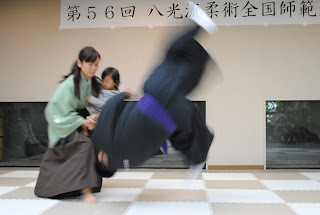 What attracts me so much to Hakkoryu is the absolute lack of physical strength that is required. If you can stand/sit up straight and have enough upper body strength raise your arm, then you can apply Hakkoryu techniques. This means that anyone can apply this system effectively. The elderly, disabled, children and women can all be as effective as the muscle bound gym junkie. It is also ideal for police and security workers. The lack of attacking techniques, and its effectiveness in controlling attackers make it a moral, legal and safe choice.
What attracts me so much to Hakkoryu is the absolute lack of physical strength that is required. If you can stand/sit up straight and have enough upper body strength raise your arm, then you can apply Hakkoryu techniques. This means that anyone can apply this system effectively. The elderly, disabled, children and women can all be as effective as the muscle bound gym junkie. It is also ideal for police and security workers. The lack of attacking techniques, and its effectiveness in controlling attackers make it a moral, legal and safe choice.脱力
An important concept in Hakkoryu is datsuryoku, written in Japanese above. Datsu (or nugu) means to remove or to take away. Ryoku (or chikara) means power. Therefore, datsuryoku refers to the power of removing all muscular strength. In fact, using muscular strength actually compromises the biomechanics of the body. This makes the techniques much less effective and also leaves you vulnerable to counters. I couldn’t comprehend this at first, and it is still a concept I struggle with. Whenever a technique does not work for me I tend to try to force it. Usually the reason the technique did not work in the first place is because I wasn’t completely relaxed when applying it. Therefore attempting to power through the technique makes it more ineffective.
The power of Hakkoryu techniques rely on basic physiology, physics and biomechanics. Eastern medical concepts from shiatsu form the basis for many techniques. All techniques follow the same basic principles: perfect posture, connectivity of the joints, breaking balance, datsuryoku and a few `secrets` I will not divulge in today`s blog. The techniques appear mystical, even magical in their effectiveness, but the principles are all very scientific.
Other jujutsu styles I have trained in also use the same principles, but Hakkoryu seems to take these to another level. In judo, BJJ and other Japanese (and Filipino) jujutsu systems I have trained all claim not to need muscular strength, but I am yet to see anyone apply these techniques as softly yet as effectively as a Hakkoryu shihan (teacher).
 The techniques themselves probably most closely resemble aikido moves, as the two systems have a similar history. Both Okuyama Ryuho Shodai Soke Sensei (the founder of Hakkoryu) and Ueshiba Morihei O Sensei (the founder of Aikido) were senior instructors of Daitoryu Aikijujutsu, the system of arguably Japan`s most influential jujutsu practitioner, Takeda Sokaku. Before his death, many instructors left Daitoryu Aikijujutsu to found their own styles. This was largely because Takeda had grown too old yet his son was too young to head the organisation with authority. Both Okuyama and Ueshiba learned other systems and outgrew Daitoryu.
The techniques themselves probably most closely resemble aikido moves, as the two systems have a similar history. Both Okuyama Ryuho Shodai Soke Sensei (the founder of Hakkoryu) and Ueshiba Morihei O Sensei (the founder of Aikido) were senior instructors of Daitoryu Aikijujutsu, the system of arguably Japan`s most influential jujutsu practitioner, Takeda Sokaku. Before his death, many instructors left Daitoryu Aikijujutsu to found their own styles. This was largely because Takeda had grown too old yet his son was too young to head the organisation with authority. Both Okuyama and Ueshiba learned other systems and outgrew Daitoryu. The biggest differences between Hakkoryu and Aikido probably lie in the teaching format, training methods and movement. Aikido trains with a compliant partner, while in Hakkoryu your partner tries to imitate an attacker more realistically and will resist the technique to varying degrees. Aikido uses flamboyant footwork, whereas Hakkoryu technique should all be able to be applied on `half a tatami mat`. There are many more differences, but these are probably the main ones I hear.
To be continued…



















